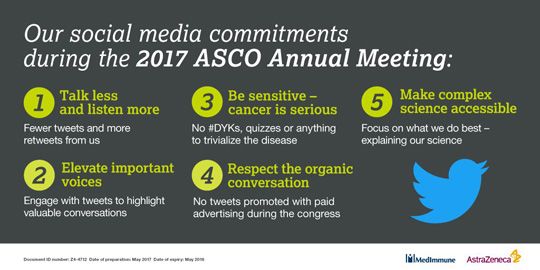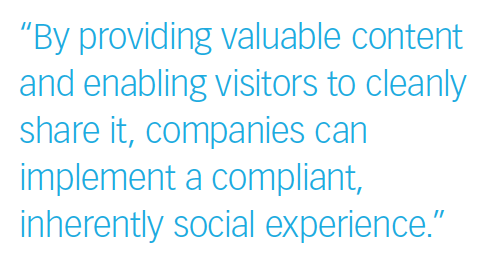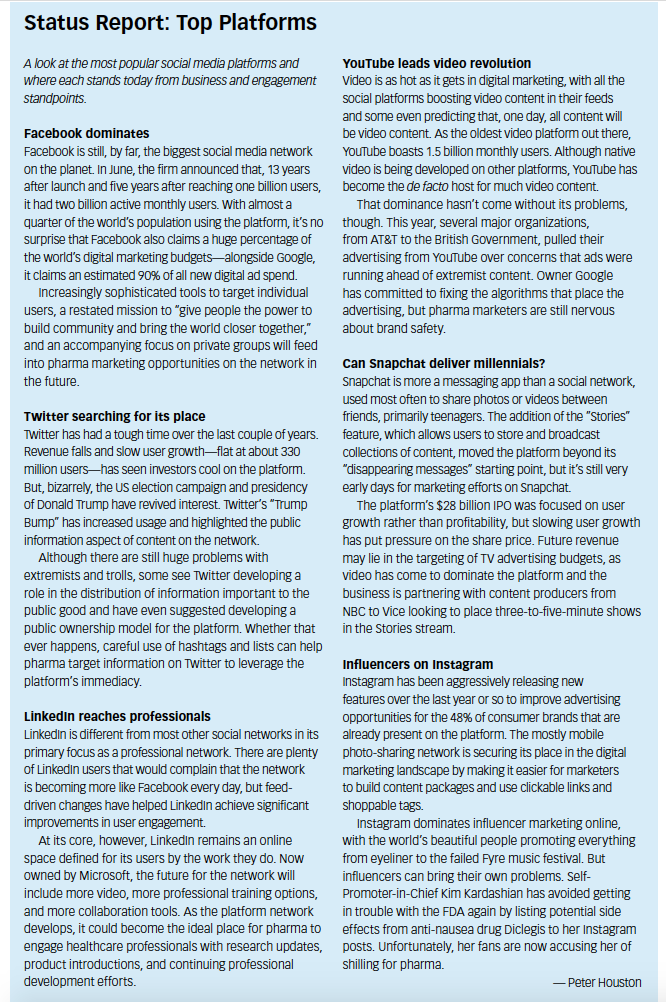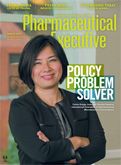The 'Hear' and Now for Pharma and Social Media
Pharmaceutical Executive
For the life sciences industry in 2017, engaging across social media means less talking-and more listening.
Pharma and Social Media: Status Update. For the life sciences industry, engaging and communicating across the vast social media sphere in 2017 means less talking-and more listening
Good news-the pharmaceutical industry is finally catching on to the social side of social media. Just a decade or so after Facebook, YouTube, and Twitter gave everyone the opportunity to share their own stories, pharma businesses are actually starting to listen.
Of course, there is still a broad spectrum of social media capabilities within the industry, from companies that are all in on the social scene to those who still haven’t managed to set up a basic account. Even within businesses, skills and usage can vary greatly between countries, therapeutic areas, or corporate functions such as HR and commercial.
The vast majority of pharma companies also still use social media as just another broadcast channel-a cheap alternative to direct mail. But the green shoots of sociability are starting to show through.
Less is more
One recent shining example is AstraZeneca’s Twitter strategy at June’s American Society of Clinical Oncology (ASCO) 2017 meeting in Chicago. Ahead of the meeting, the company released a statement saying that it would be tweeting less and engaging more with retweets and comments.
The business was reacting to concerns expressed at 2016’s ASCO meeting, when some attendees worried that vital social media conversations around the event were getting lost among louder industry voices. The worry was that paid promotions were threatening to crowd out valuable scientific conversations.
AstraZeneca’s response was to publish a set of commitments to be "Being a Better Social Media Citizen." In a five-point pledge (see slide below), the company promised to preserve the social media space around the conference and allow the oncology community to “learn, discuss, and share the science that excites them at ASCO 2017.”
Click to enlarge

Key to this was “talking less and listening more,” meaning a significant reduction in tweets sent. The flip side of that was “elevating important voices,” sharing tweets sent by researchers, patient organizations, doctors, and patients.
AstraZeneca also drew back from frivolous content like quizzes or fun facts to “be sensitive” and acknowledge that oncology is a serious business. And the drugmaker stopped paid promotion of tweets for the duration of the meeting to “respect the organic conversation” taking place on Twitter among ASCO attendees and the broader medical community.
Finally, the company’s social media team committed to focus on explaining its own science in formats that were easy to digest and understand and “make complex science accessible.”
Contributing to the conversation
AstraZeneca’s “less is more” strategy appears to have contributed to a better online experience at ASCO 2017.
More than half of the 200-plus respondents to a Twitter poll by ASCO member Dr. Mike Thompson, with the University of Wisconsin School of Medicine, thought the 2017 meeting had a better “signal-to-noise ratio” than the previous year’s meeting.
Dr. Paul Tunnah, CEO of healthcare engagement agency Pharmaphorum Connect, was encouraged that AstraZeneca had carried through on its promises. “This is a good example of progressive social media,” he says. “They received positive feedback from the medical audience and stood out as being engaging rather than broadcasting.”
Annie Sullivan, director of corporate social media, AstraZeneca, says that while it approaches every congress or campaign with a fresh lens, being a “good citizen” is now central to the company’s social media strategy.
She explains that the business wants to deliver content that has a value through its social media channels, making its science accessible, highlighting important professional voices and sharing patient perspectives. “We are focused on remaining relevant to the ever-changing social media landscape,” says Sullivan.
Crafting campaigns
The issue of relevancy features in Tunnah’s 2017 formula for the ideal social media campaign: “Integrated, relevant, and long-term.”
Being relevant, according to Tunnah, means that campaigns need to provide information that is useful to the target audience. He says corporate objectives and messaging can be encapsulated in valuable information, but that marketers must avoid “corporate-speak.”
Being integrated requires social media linking to other digital and non-digital content that takes the customer on a clear journey to learn more about the company or a specific therapeutic franchise. And to be

long-term, Tunnah says that pharma needs to be ever-present on social media, not just when it wants something.
Long-term commitment and social media marketing don’t always sit well together. Corporate concerns over ROI that is not always easy to prove and the frequent pivots of the social platforms conspire to shorten campaign time frames. But Tunnah advises the long view.
“Short-term campaigns will not deliver results without significant paid promotion, which may not deliver relevant audience,” he explains. “Trust takes time and the authenticity that being there more persistently provides is very powerful in building better customer relationships.”
Making connections
According to Jordan Deatherage, senior director, social media, at Intouch Solutions, the ideal social media campaign also needs to make a connection, regardless of the platforms or the technology being used.
She advocates a consistent and connected customer experience, not a mismatch of information or user experience. “Each messaging point of contact should be intentional and function in an expected way,” says Deatherage.
She believes it is possible for companies to be social without building a branded presence on specific platforms, so long as they understand that social media is an important part of people’s day-to-day
Sidebar: Reaching Across Disease Areas (click to enlarge)

communication.
“Information on the Internet is social if it’s shareable,” says Deatherage. “By providing valuable content and enabling visitors to cleanly share it, companies can implement a compliant, inherently social experience.”
In this way, companies can take on social media without setting up an owned brand presence like a Facebook page. But that doesn’t mean there is no value in developing an owned social presence.
Deatherage points to the work Intouch has done with Teva to develop its Lift MS Facebook page and blog. The award-winning Facebook page has almost 320,000 followers and hosts patient resources, discussions, and supporting videos and photos. “The Lift MS Facebook page and blog have contributed in a relevant way to this community in a very crowded category,” says Deatherage.
Teva previously had success with the “You Don’t Know Jack About MS” YouTube channel fronted by multiple sclerosis sufferer Jack Osborne. The channel gained 11,000 subscribers and the most popular of the 16 episodes clocked up almost half-a-million views.
“The two campaigns aren’t linked, but they are both a testament to a client that understands the impact of social media, especially in a very crowded disease state,” says Deatherage.
Making progress
In general, pharma is making inroads with social media. But there’s more that could be done.
Tunnah believes there is a big opportunity for pharma companies to embrace using social media for proper “customer service”-for doctors and patients-in the same way consumer companies are doing. “No one has made this bold move yet, but it is possible, provided compliance processes are mapped out the right way and non-compliant/product conversations are directed off social media,” says Tunnah.
Deatherage is excited by the prospect of clients embracing a more robust digital presence and thinks that most of the brands participating seriously on social media are doing a decent job, given drug industry constraints, as compared to other industries. “You’re never going to see campaigns like Wendy’s has done in the pharma space and we all know that,” says Deatherage.
Where she does see scope for improvement is how pharma companies are handling their corporate social media presence. “Corporate accounts often set the tone for how brands can behave online,” says Deatherage. “Seeing companies only push out boring press releases or canned stock footage videos is disheartening.”
AstraZeneca, continuing discussions with influencers around best practices, also sees broader opportunities to engage with stakeholder groups through social media.
Sullivan highlights patients sharing their experiences with diseases, the impact on their lives, and documenting their treatment journey; physicians using social media to stay current on the latest research and to connect with patients; and researchers taking to social media to find collaborators and “talk shop” with fellow scientists.
“And all our key audiences have a stake in the future of scientific advancement,” says Sullivan.
Preferred platforms
Pharma has traditionally focused on Twitter and Facebook, but Deatherage believes Facebook is the best social platform for the industry, both from reach and compliance perspectives. “It gives pharma brands the most options when it comes to settings and ISI (important safety information),” she explains.
Click to enlarge

Tunnah doesn’t disagree, but says there may also be a major opportunity on LinkedIn, due to the level of engagement it offers and differentiation of the data the platform can deliver due to its unique role as a “professional” social network.
Returning to the listening theme that has come to underpin so much modern social media planning, Deatherage says Intouch is consistently providing clients with social listening research and insights around patient and healthcare professional comments. “Updates based on that research may take a while to implement, but it is a requested feedback loop right now.”
And will need to be for a long time to come, if pharma wants to be truly social on social media.
Peter Houston is a media and marketing expert and the founder of Flipping Pages Media. He can be reached at peter@flippingpagesblog.com

The Misinformation Maze: Navigating Public Health in the Digital Age
March 11th 2025Jennifer Butler, chief commercial officer of Pleio, discusses misinformation's threat to public health, where patients are turning for trustworthy health information, the industry's pivot to peer-to-patient strategies to educate patients, and more.
Navigating Distrust: Pharma in the Age of Social Media
February 18th 2025Ian Baer, Founder and CEO of Sooth, discusses how the growing distrust in social media will impact industry marketing strategies and the relationships between pharmaceutical companies and the patients they aim to serve. He also explains dark social, how to combat misinformation, closing the trust gap, and more.
The Misinformation Maze: Navigating Public Health in the Digital Age
March 11th 2025Jennifer Butler, chief commercial officer of Pleio, discusses misinformation's threat to public health, where patients are turning for trustworthy health information, the industry's pivot to peer-to-patient strategies to educate patients, and more.
Navigating Distrust: Pharma in the Age of Social Media
February 18th 2025Ian Baer, Founder and CEO of Sooth, discusses how the growing distrust in social media will impact industry marketing strategies and the relationships between pharmaceutical companies and the patients they aim to serve. He also explains dark social, how to combat misinformation, closing the trust gap, and more.
2 Commerce Drive
Cranbury, NJ 08512
All rights reserved.